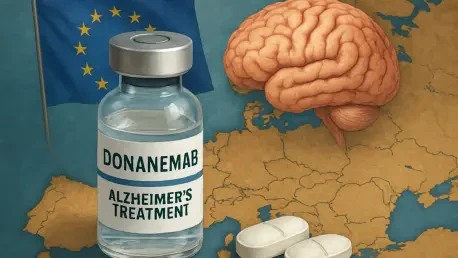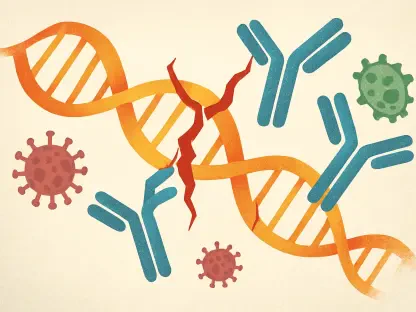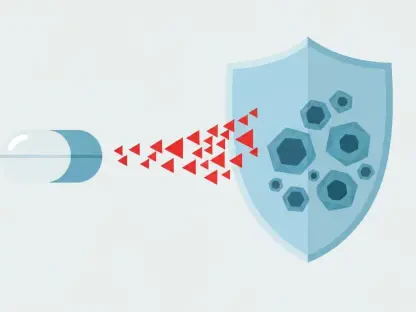What if a single monthly infusion could halt the heartbreaking decline of memory and independence for millions of Europeans with early Alzheimer’s disease, bringing hope to families across the continent? This question, once a distant dream, now edges closer to reality with donanemab, a pioneering drug that has captured the attention of medical experts and patient advocates throughout Europe. For families watching loved ones fade into the fog of this devastating condition, the possibility of slowing its progression offers a lifeline worth exploring. This development signals a potential turning point in a field long plagued by limited options, sparking curiosity about whether this therapy could redefine care standards in Europe.
The significance of this story lies in the sheer scale of Alzheimer’s impact, affecting up to 6.9 million people in Europe, and the urgent need for effective interventions. As a progressive neurodegenerative disorder, Alzheimer’s strips away cognitive function, leaving patients and caregivers grappling with profound challenges. With donanemab receiving a positive recommendation from the European Medicines Agency’s Committee for Medicinal Products for Human Use (CHMP), there’s a tangible chance to address early-stage cases more effectively. This moment represents not just a scientific milestone but a beacon of hope for countless individuals awaiting better solutions.
A New Dawn for Alzheimer’s Care
The journey toward innovative Alzheimer’s treatments has been marked by decades of frustration, with many promising therapies failing to deliver. Yet, donanemab, developed by Eli Lilly and marketed as Kisunla in some regions, emerges as a potential game-changer. Recommended for approval by a key European health committee, this drug targets adults with early symptomatic Alzheimer’s, specifically those with confirmed amyloid pathology and certain genetic profiles. Its arrival stirs optimism among those desperate for tools to combat the disease’s relentless advance.
Unlike previous treatments that merely managed symptoms, this therapy offers a chance to alter the disease’s trajectory. Administered through a monthly intravenous infusion, it focuses on clearing toxic amyloid plaques in the brain—a hallmark of Alzheimer’s pathology. This approach, if fully authorized, could provide a critical window of time for patients to maintain independence and quality of life, reshaping the narrative around early intervention in Europe.
The Growing Urgency for Alzheimer’s Solutions
The burden of Alzheimer’s extends far beyond individual patients, straining families and healthcare systems across the continent. With millions affected, the disease creates a ripple effect, demanding vast resources for care and support as patients lose the ability to perform even basic tasks. This escalating crisis underscores why breakthroughs in treatment are not just desirable but essential to alleviate both emotional and economic pressures.
Current options remain woefully inadequate, often limited to symptom management rather than addressing underlying causes. The emergence of donanemab arrives at a pivotal moment, responding to the clamor for therapies that can slow cognitive decline in the early stages. As Europe grapples with an aging population, the need for such innovations becomes ever more pressing, highlighting the stakes involved in bringing this drug to market.
How Donanemab Works and Why It Stands Out
At its core, donanemab operates by targeting amyloid plaques, helping the body eliminate these damaging brain deposits that contribute to Alzheimer’s progression. Delivered via a monthly infusion, the drug has shown remarkable promise in clinical settings. Data from the TRAILBLAZER-ALZ 2 trial revealed a significant reduction in cognitive and functional decline among early-stage patients, offering a concrete measure of its potential impact.
Further bolstering its case, results from the TRAILBLAZER-ALZ 6 study demonstrated a refined dosing schedule that cuts down on side effects like brain swelling, known as amyloid-related imaging abnormalities. Designed for patients with specific genetic markers—namely ApoE4 heterozygotes or non-carriers—this therapy paves the way for a more personalized approach. Such tailoring could set a new standard, ensuring treatments align closely with individual biological needs.
This focus on precision medicine marks a departure from one-size-fits-all strategies, positioning donanemab as a leader in the evolving landscape of neurodegenerative care. If approved, it could benefit thousands by delaying the slide into more severe stages of Alzheimer’s. The evidence suggests a transformative potential, provided access and implementation are handled effectively across diverse European healthcare systems.
Perspectives from Experts and Advocates
Voices from the medical and advocacy communities reflect a shared excitement about what donanemab could mean for patients. Patrik Jonsson, executive vice president at Eli Lilly, described the drug as a “meaningful step” for those with early Alzheimer’s, stressing the company’s commitment to advancing research through ongoing trials. His perspective highlights the dedication behind this innovation, framing it as part of a broader mission to tackle unmet needs.
Echoing this sentiment, Jean Georges, executive director of Alzheimer Europe, praised the therapy as a crucial addition to the limited arsenal of disease-modifying treatments. He pointed to its unique dosing and stopping regimen as a noteworthy feature, urging swift approval by the European Commission to accelerate patient access. This advocacy underscores the urgency felt by those on the front lines of the Alzheimer’s battle, who see this drug as a vital tool for change.
The consensus among stakeholders is clear: timely authorization could catalyze critical conversations about pricing and reimbursement at national levels. Their collective push for progress reveals a deep-seated hope that this therapy will not just be a scientific achievement but a practical lifeline for those in need. This alignment of industry and advocacy efforts amplifies the call for action, emphasizing the human stakes at play.
Steps Forward for Patients and Families
While the final decision from the European Commission looms, patients and families can take proactive measures to prepare for potential access to donanemab. Engaging with neurologists to assess eligibility is a critical first step, especially since genetic testing for ApoE4 status plays a key role in determining suitability for this treatment. Early discussions with healthcare providers can help clarify whether this therapy aligns with individual circumstances.
Staying abreast of national health policies is equally important, as drug availability, costs, and reimbursement frameworks will differ across European countries. Families should monitor updates from health authorities to understand how these factors might affect access. Such vigilance ensures that when the drug becomes available, there are no delays in navigating the bureaucratic landscape of healthcare systems.
Additionally, connecting with organizations like Alzheimer Europe offers a wealth of resources and a platform to advocate for equitable distribution. These groups provide support and amplify patient voices in discussions about access, ensuring that the needs of those affected are not overlooked. Taking these steps empowers families to be ready for the opportunities this therapy might bring, turning hope into actionable preparation.
Reflecting on a Milestone in Alzheimer’s Care
Looking back, the recommendation of donanemab by the CHMP stood as a defining moment in the fight against early Alzheimer’s in Europe. It represented a shift toward therapies that tackled the disease at its roots, backed by compelling trial results that promised to slow cognitive decline. The focus on personalized treatment through genetic profiling added a layer of sophistication to care that was previously unimaginable.
As the European Commission deliberated, the path ahead hinged on ensuring swift authorization and addressing barriers to access across diverse regions. Collaboration between policymakers, healthcare providers, and advocacy groups became crucial to translate this scientific progress into real-world impact. The challenge remained to balance innovation with equity, so that every eligible patient could benefit from this advancement.
Ultimately, the story of donanemab underscored the power of perseverance in medical research, pointing toward a future where Alzheimer’s might no longer be an unstoppable force. Continued investment in such therapies, alongside efforts to streamline delivery, offered a roadmap for tackling other neurodegenerative challenges. This milestone reminded all stakeholders that progress, though incremental, held the potential to restore dignity and time to those who needed it most.









